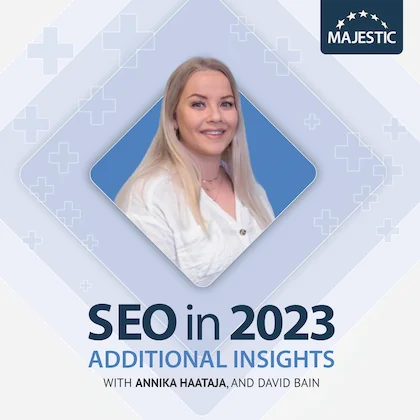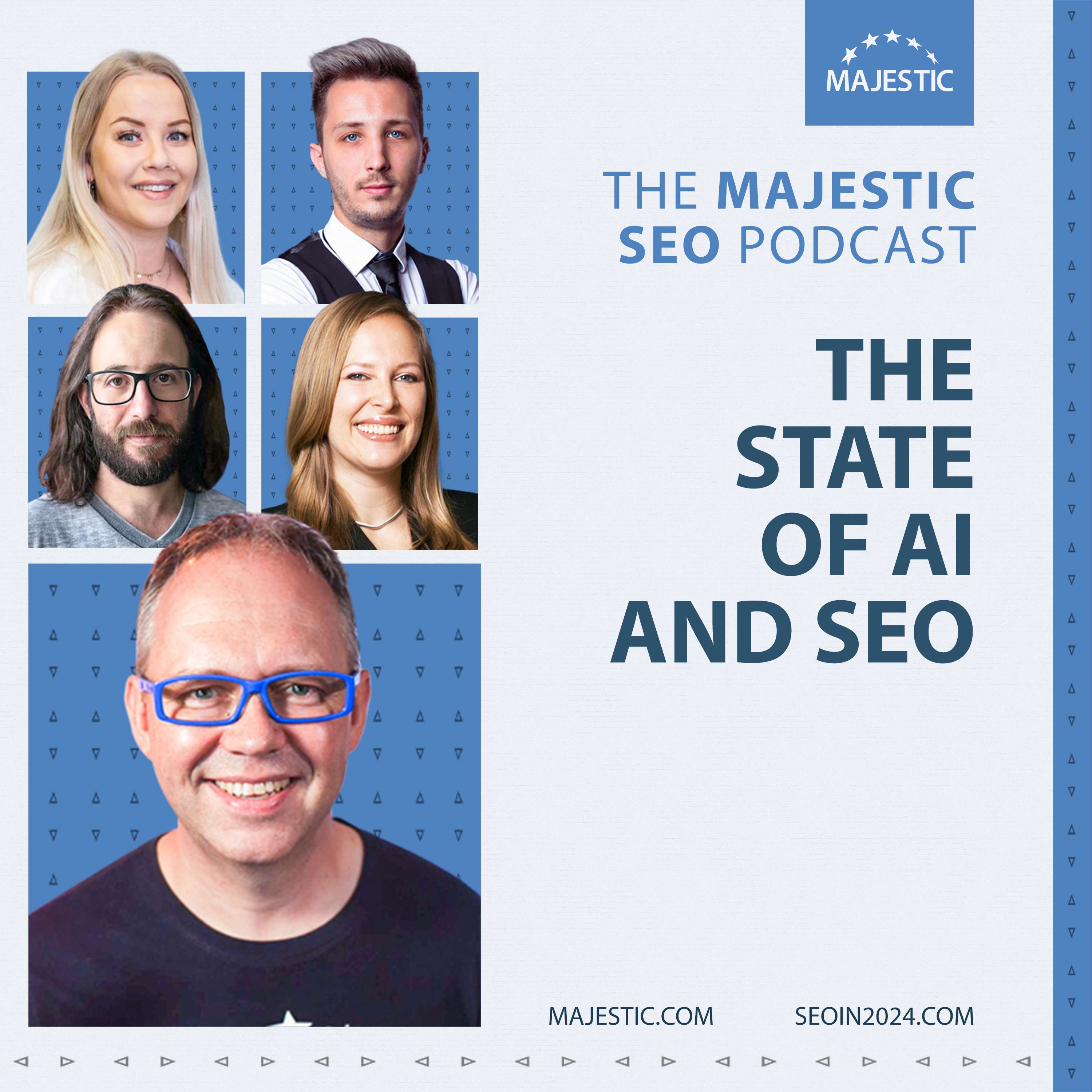-
Site Explorer
- Majestic
- Summary
- Ref Domains
- Backlinks
 New
New Lost
Lost- Context
- Anchor Text
- Pages
- Topics
- Link Graph
- Related Sites
- Advanced Tools
- Author ExplorerBeta
- Summary
- Similar Profiles
- Profile Backlinks
- Attributions
- Compare
-
Link Tools
- My Majestic
- Recent Activity
- Reports
- Campaigns
- Verified Domains
- OpenApps
- API Keys
- Keywords
- Keyword Generator
- Keyword Checker
- Search Explorer
- Link Tools
- Bulk Backlinks
- Neighbourhood Checker
- Submit URLs
- Experimental
- Index Merger
- Link Profile Fight
- Mutual Links
- Solo Links
- PDF Report
- Typo Domain
- Free SEO Tools
- Support
Unite SEO and wider brand strategy for enhanced engagement
Annika Haataja
Annika Haataja wants SEO to unite their SEO and wider brand strategy for better user engagement from target audiences.

Annika Haataja says: “My tip for 2023 is to unite your SEO and wider brand strategy for better user engagement from your target audience to talking about why it's important, and I guess, how to get going with it.”
What does uniting SEO and wider brand strategy mean?
“It's to utilize the information you gain when doing SEO, potentially building brand campaigns, and vice versa. So there can be many benefits in considering your brand as a whole when you're building your SEO strategy, mainly talking about content strategy and other areas where content will be primary when building any campaigns. In this day and age, SEO is getting hard. It can be more difficult to stand out by just doing more traditional optimization, which no longer works. Also, user behavior has changed quite a lot, especially in recent years. When we're looking at COVID, the cost of living crisis and user buying behavior has changed massively. And those traditional methods don't work anymore, especially in industries like E-commerce and tech. And when looking at even AI, there's a lot of potential spam that users might be seeing now more, like auto-generated content, fake reviews, maybe even fake personas. So, I think users generally have a bit of a trust issue towards websites now. So they're not buying from just any website; they want to buy from brands they know or trust. And when we're looking at brands, if you nail your branding, you don't necessarily need to have the highest engagement rate or the best Core Web Vitals anymore. You can start growing through brand optimization. And they assist each other. So, when you're growing your brand, your SEO can improve. And when you're good at SEO, your brand awareness can increase as well. So it's a bit of a win-win situation for sure.”
So what are the specifics behind the type of brand campaign that you're referring to? And what kinds of little wins can the SEO gain from that?
“So, we're looking at different brand messaging. For example, you might have teams that utilize that brand messaging and a comms team that works mainly in PR. This product team focuses on improving the product, understanding the customer pain points, and all these teams have very specific data they utilize. And that could be like a massive goldmine for an SEO as well. When we're talking about integrated strategy, we want to make sure that, you know, the prime messaging and tone of voice is consistent across the board. So whether we're talking about optimizing content on your site versus digital PR versus PPC, or social media, we don't want any distinction or differentiation between what we're trying to say, who we are speaking to, etc. So there's a lot of things that we can learn from other teams, different campaigns that have been built. If we're looking at PPC and the kind of messaging they utilize for your brand, they do a lot of quick A-B testing in the headlines, which is not necessarily possible with SEO. Sometimes, these things take a long time to gather that data. By talking to these teams and understanding what works for them, we can also utilize that information in our work.”
In the past, brand teams came up with strap lines that weren't necessarily SEO friendly, perhaps engaging or appealing to the target audience, but not something likely to be searchable. Is that still an issue nowadays? Is it ideal for developing and incorporating highly searched terms within brand straplines? Or can you build a brand and a strapline and then build your traffic based upon that so you don't need the keyword volume, to begin with?
“I guess it all comes down to your general authority in the industry. So, if you want to build topical authority within an existing topic, it's best to have an SEO or a content marketer in the team to assist with the brand message building. However, if you're in a new, niche industry where that search doesn't exist, the main important thing is looking ahead. When you're building your strategy. What are the KPIs that you're trying to achieve when, you know, you're trying to build not only an SEO content strategy but also a brand strategy? So one very interesting metric that I know some other companies use is what we call share of search. So going around market search and information about competitors, you can justify spending more on SEO and brand when you bring these metrics to your stakeholders. So, with the search share, we can compare our brand search volume to our competitors’ search volume in our specific niche. I know some people say to compare your brand to your competitors. But if you do have some data, whether it's on Google Trends or other potential tools around your brand, and then the keyword itself, whether it's your solution, your product, your service, that can bring really interesting insights into how far are you already with your brand? Do consumers know you? Do they understand what you do? And then that metric can be interesting to put in your actual SEO reports because it's something that you can measure month to month. You can even create pie charts. And that's the kind of those are the kinds of metrics that often stakeholders are very interested to know. Because they want to know how big the market is. What is our size of the pie? And when can you justify it? Well, we want to increase because our main competitor is, let's say, 20%. But we're only 17%. We also want to get there by investing more in SEO and brand building.”
Share of search is certainly an interesting metric because it's not necessarily a metric that an SEO not thinking about a brand would immediately come to because I guess the trend nowadays is to look at ROI and look at where you're gathering traffic from and then to drive out into to some purchase. But if the share of search means something to a brand team, then a better question would be to the brand team. What metrics are important to you? And how can I help you work towards achieving those metrics? So those are the conversations that SEOs and brand teams should have together?
“So, when we're talking about integrating strategies, it's important we know what we're trying to achieve as a collaborative approach. So if often, they seem they can push each other a bit more forward when we're assisting the brand team with their KPIs. They can assist us with our KPIs. And obviously, there might be some, you know, shared KPIs that can be very relevant, for example, branded versus unbranded searches. So when we're talking about the distinction between unbranded and branded, often SEOs like to focus on unbranded because it feels like that's where the money is that our shows our value that shows how good we are at SEO, because we're achieving top three positions for a specific solution or product keyword. When talking about branded searches, we all know that they converge twice as better compared to the minimal search volume. So, it makes sense to understand the brand, circling, and especially navigational searches. It's really interesting when you act as a user and search your brand in different areas, whether the traditional organic news, Google Images, or AI searches, and understand what that kind of SERP area looks like. Are you currently owning it? Or is somebody else owning your brand, which often happens when we do off-site SEO? We get really good links from articles. However, suppose we're talking about sort of direct brand searches. When you compare what your SERP looks like to what your competitors’ SERP looks like, that can be really interesting information to utilize when you're starting to build your strategy and understand where the focus is currently in your industry.”
So what does this mean in terms of how SEO teams and brand teams should work more effectively together? Should they be working as part of the same team? Should they be meeting up once a week? Should they have a quarterly catch-up and be involved in strategy meetings? What does that look like?
“I guess it looks different in different companies. It depends on how far you are with your brand building and SEO. One thing that I think all teams should do is ensure that you have specific brand guidelines available. So quite often, we see that these documents don't necessarily exist, which is not the worst thing in the world. These teams must come together, it's whether it's a content team, comms team brand team, and start putting together these documents and make sure that these are always utilized when we write any content, whether it's on-site or any link-building campaigns because that very much explains what the brand’s core values are? What is the target audience, and what are the different user profiles? It's really important to understand them to speak to the user as you would as a brand. And things like tone of voice documentation can be very beneficial for your content writers to start writing as the brand rather than themselves. Because sometimes it's difficult to make that distinction when you produce content. So, essentially, make sure that you've got all the sort of brand guidelines available, set relevant KPIs for the SEO and brand teams, and monitor those KPIs you use to stick to them. And when you start doing research for your content strategy, that's when it is more important to have that collaboration with the different teams. If it's impossible to do it frequently, at least when building and reviewing our strategy. So, utilizing the data from other teams can be very beneficial. That's when you want to bring them in while building your strategy.”
Are you talking about how brand and SEO teams working more closely together can result in better and more enhanced engagement? What is enhanced engagement? Are you talking about higher click-through rates from the SERP? Or are there other metrics that you can pin that on?
“Yeah, it could be higher click-through rates but also conversions in general. So when we're gathering this data from my different teams, you can look at your customer views or inquiries. What are the actual pain points that your users are experiencing that you don't necessarily see through your data? So if you go to the customer service data, you might learn more about the general email inquiries your company is getting. And therefore, you can draw some conclusions even in the search phase. What are the sort of main pain points that users might be experiencing? And when you meet those pain points and produce a solution for them, they're more likely to convert as well. And I guess, very important to make sure that the brand is at the center of everything. Once we're ready to start building the brand, we've got different teams working on it. Whether it's digital PR, for example, it can be a great way to take control of the brand message because if you're in a slightly bigger market, there might be a lot of talk about your brand already. If you're a more mature business, you need to control this messaging because digital PR can be great for reputation management. We want to know what is said about our brand, and then we can also produce some content that makes our brand seem more positive in the eyes of the user.”
So, you mentioned things like reputation management. Should these elements be part of an SEO strategy? Because most SEO strategies nowadays still look at long tail keyword phrases and organic traffic, new traffic can come in, but are you talking about incorporating elements like engagement and conversion rates and reputation management within an SEO strategy?
“Yeah. If there's a budget, then it can be really important because when we're looking at our branded searches, there might be a lot that we're missing out. If we're focusing on long-tail keywords, potentially bottom of the funnel, top of the funnel, that's sort of the more traditional, almost easy SEO we can do. But when we're looking at navigational searches, that can give us much more information around the wider focus for the user when looking for our services or products. When we get that coverage, whether negative or positive, that might change the searches. So it can be really interesting because, especially when we're trying to make the justified spend on digital PR, it can be very difficult because a lot of these metrics are quite what we call vanity metrics, like DR, coverage, etc. Because often, your stakeholders can come to you and say, well, great, we got a link from a Tabloid. But what's the referral traffic? How much money did we make with that link? And that cannot be easy to justify or attribute to the work. So, it can be a very good way of showcasing the value of digital PR, making sure that our reputation and brand image are positive in the SERPs.”
You shared what SEO should be doing in 2023. So now, let's talk about what SEO shouldn't be doing. So what's something that's seductive in terms of time but ultimately counterproductive? What's something that SEOs shouldn't be doing in 2023?
“I think a key thing, when we're talking about a brand, is not to fall into the trap of over-saturating the market with your brand. It can be in the form of posting a blog post every single week, multiple times a week, or posting on social every day. Let's see a lot of ads on social or digital PR campaigns multiple times a month. If you're churning out this type of content around your brand as quickly as possible to different channels, maybe trusted, even tested mistakes, it can be detrimental to your action. So, for example, with digital PR, we often see that you can even tarnish some, you know, existing relationships with journalists if you're constantly churning out content. And there's likely not to be a massive uplift, especially if the campaign is irrelevant or connected to your brand. So be smart with your approach, with a brand focusing on quality versus quantity, and take your time speaking to the different teams and combining data from different channels to ensure the brand is at the center of your activity. And take time to build these campaigns and make sure they are effective.”
Annika Haataja is head of SEO at Seeker Digital.
Also with Annika Haataja

SEO in 2025
|
Like Rejoice Ojiaku in "Identify the archetype of your brand", Annika Haataja from Seeker Digital believes in the power of the brand, and she believes that brand should be central to everything that you do. |

Majestic SEO Podcast
|
Annika Haataja, Tejaswi Naidu, Garrett Sussman and Pam Aungst Cronin to discuss the past, present and future of AI in SEO.
|

SEO in 2024
|
According to Annika Haataja from Seeker Digital, one of the key questions that you should be asking prior to implementing the use of AI in your workflow is “How might AI impact user behaviour?” |
Choose Your Own Learning Style
 Video
Video
If you like to get up-close with your favourite SEO experts, these one-to-one interviews might just be for you.
Watch all of our episodes, FREE, on our dedicated SEO in 2023: Additional Insights playlist.
 Podcast
Podcast
Maybe you are more of a listener than a watcher, or prefer to learn while you commute.
SEO in 2023: Additional Insights is available now via all the usual podcast platforms
 SEO in 2023
SEO in 2023
Catch up on SEO tips from 101 SEO experts in the original SEO in 2023 series
Available as a video series, podcast, and a book.
Could we improve this page for you? Please tell us




